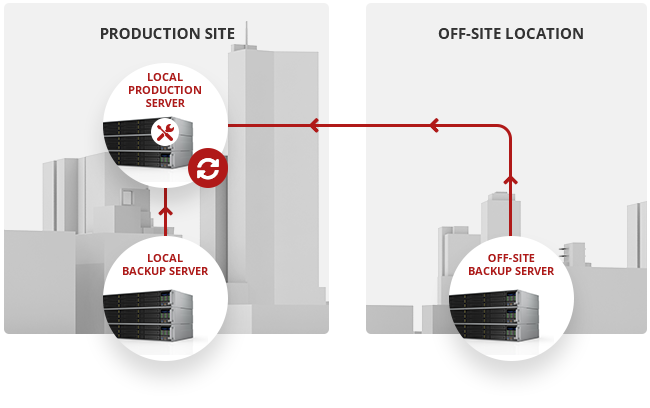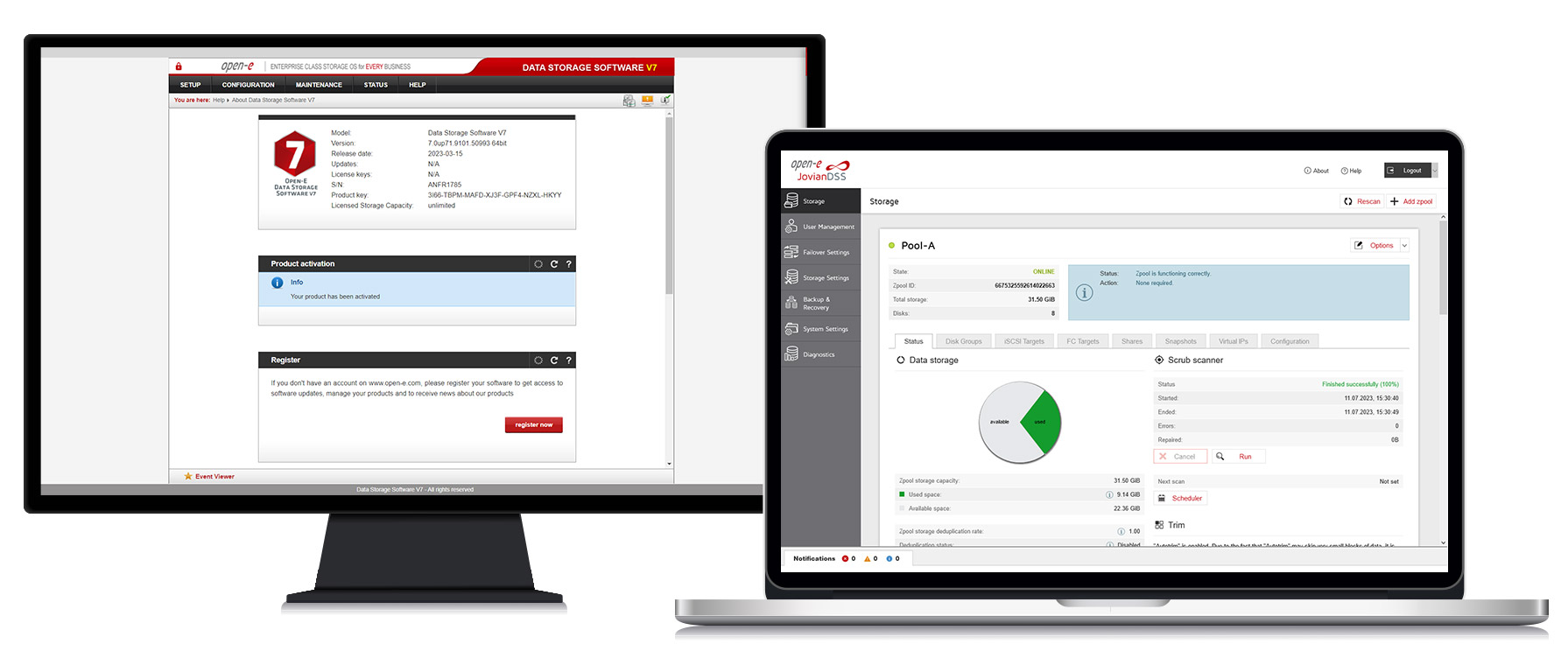Over the past 25 years, Open-E has had to say goodbye to old “friends” several times. We are emotionally attached to our previous products because of the work and dedication we have put into developing them and learning how to make their successors more reliable, efficient, secure, and comfortable for our customers to use. The time has come to say goodbye to one such old friend – Open-E DSS V7. It was a long-lasting product with great potential. A big step we learned a lot from. E.g., by later switching from XFS to ZFS in Open-E JovianDSS, which opened a lot of opportunities to improve our flagship product and expand future possibilities to grow.
This is an excellent opportunity to show you, dear users, that moving to Open-E JovianDSS will improve your data infrastructure and extend new opportunities for yourself, your company, and its prosperity. This ZFS-based data storage system offers much more efficient management of your data storage infrastructure with automated processes that Open-E DSS V7 could not even handle. It offers On- and Off-site Data Protection and High-Availability seamless cluster configurations, making data more secure and accessible. And that’s just the tip of the iceberg of what can be achieved by switching to Open-E JovianDSS.
So, to make it easier for you, we have prepared a comparison of these two products divided into modules of functionality types. You can find the most useful and valuable functions systems offer (yes/no) and which features Open-E JovianDSS expands (yes +). These are only the most notable examples. The list would be too long if we included all the features. You will realize that migrating from Open-E DSS V7 to Open-E JovianDSS is necessary to experience a new and improved system that will benefit your business in the long run.
ADMINISTRATION
The administration features consist of components that manage the user interface, the access control, and the functions that handle the updates or rollbacks of the data infrastructure. To improve usability, efficiency, and ease of work, we have implemented REST API support. This enables the system management without a GUI, work automation, or plug-in creation to facilitate the integration of Open-E JovianDSS in your own solutions or external systems and automate them, which enhances compatibility.
Open-E DSS V7 offers the mirrored boot medium drive capability only on hardware RAID, which is a functionality extended in Open-E JovianDSS to both – hardware and software. As a result, the operating system works even once the system drive fails, so the other can take its functions in case of running the whole system as well, no matter which type of RAID you use.
If you wish to learn more about Open-E JovianDSS Administration module read this article.
NETWORK MANAGEMENT
This section includes settings for various network parameters, virtual IP settings, data transfer packet sizes of your choice, and many others responsible for managing your data infrastructure via the network. In Open-E Jovian DSS, we have implemented RDMA support on the mirror path, which facilitates data synchronization between nodes and significantly improves the cluster performance.
VLAN feature allows a client to host multiple IPs on a single network card by using virtual networks.
If you wish to learn more about Open-E JovianDSS Network Management module read this article.
STORAGE MANAGEMENT
This section comprises the functionalities and elements to configure, monitor, and manage the data storage. These features include the management of RAID and logical volumes – data pools, and datasets. Open-E JovianDSS, unlike Open-E DSS V7, is based on ZFS architecture, which offers many opportunities to automate and simplify multiple processes.
The previous system version allowed up to 20 snapshots defined in the system. With Open-E JovianDSS, the snapshot number increased to hundreds of thousands. Another remarkable feature is the ability to create multiple snapshots per one logical volume at a time, clones from snapshots (their writable versions), and revert data from snapshots automatically. There are also data deduplication and compression functions applied. They help you save a lot of storage space and improve the efficiency of your storage by eliminating duplicates and shrinking the size of files. The older system requires you to move the data manually from one location to another and offers a limited number of snapshots. Open-E JovianDSS offers excellent support for data encryption. It comes in handy while working with Self-Encrypted Drives, which enhances the security of the data written on disks.
Other important functionalities of Open-E JovianDSSS not present in Open-E DSS V7:
- Special data allocation classes that allow for keeping ZFS metadata and small files only on high-speed drives.
- SSD-Trim & Auto-Trim that help to recover free space from deleted data.
- VMware ESX Auto Storage Rescan responsible for resanning and displaying a data store after system restart if Open-E JovianDSS is used as a data store in VMware.
Besides that, the Data Migration Tool allows seamlessly moving data from Open-E DSS V7 to Open-E JovianDSS, making the transition process much easier.
EXPANDING STORAGE
Expanding storage is an option crucial for growing business. That’s why we have implemented some features to Open-E JovianDSS that make that possible and reliable. Each pool disk can be replaced with a larger capacity device by using the tool available in TUI (Extended tools: Expand pool size after replacing disks to larger-sized) and thanks to Instant Pool Expansion increasing capacity has never been easier.
If you wish to learn more about Open-E JovianDSS Storage Management and Expanding Storage functions read this article.
HARDWARE & MONITORING SUPPORT
This section covers managing voltage plan, temperature status (along with fan speed), and disk health monitoring. More advanced Open-E JovianDSS allows you to determine the hardware life span and disk latency with check_mk applied or find bad sectors.
CPU frequency scaling enhances the system performance by increasing the processor’s frequency when needed or decreasing it, which reduces energy consumption.
Local Benchmark Tool with Custom Test Profile enables throughput and IOPS testing, allowing you to perform local (offline) hardware performance testing. That allows for determining Open-E JovianDSS performance on the hardware it will manage.
Alert Threshold Setting – allows you to define the values or ranges of values for specific parameters that will trigger an alert when exceeded or violated. Thus, you can monitor how Open-E JovianDSS uses your system resources and set it to relevant values your hardware may handle.
SPECIFIC NAS FUNCTIONALITIES
Metadata Pinning speeds up the time it takes to preview the datasets by caching their whole content.
Windows Active Directory provides a centralized and scalable solution for user and group authentication and authorization in an Active Directory domain. This feature enhances the security and efficiency of the network management, as it supports trust relationships between domains and subdomains.
SPECIFIC SAN FUNCTIONALITIES
Open-E JovianDSS is much more flexible and reliable in configuring disk space with its Fiber Channel Failover. Another advantage is ALUA Passive State Mode Selection implementation allowing to choose how the host handles the paths to a LUN that are in the passive state.
DATA REPLICATIONS & BACKUP UTILITIES

Open-E JovianDSS provides our proprietary functionality – the On- & Off-site Data Protection. Implementing this to the prior software version was impossible, as it was incompatible with Open-E DSS V7 architecture. Leveraging ZFS, Open-E JovianDSS provides superior data protection and performance optimization in a single feature.
On- & Off-site Data Protection includes many backup utilities, such as local and external backup, with the possibility of switching the backup server to production mode. It integrates various backup destinations (e.g., virtual tapes and tape library/autoloader support with retention time), provides ongoing data protection without a backup window, and protects against the consequences of ransomware attacks. Disaster recovery is achievable for data saved in various time spans from 1 minute to several years, with up to 1-minute recovery point objective. Also, the entire operation system can be backed up as a virtual machine, which shortens the recovery process significantly.
Additionally, Apple data backup (MacOS Time Machine), regardless of snapshots, is now also available in contrast to Open-E DSS V7 that do not offer such a feature.
CLUSTER MANAGEMENT
This section addresses a wide range of features that handle a shared storage cluster architecture. The High-Availability feature to ensure business continuity without any downtime is now possible as a seamless integration process. The High-Availability Cluster is now also being supervised by a watchdog.
INTERFACE & PERFORMANCE
Last but not least, we have enhanced the setup wizard, added the help feature with search and indexing capabilities, improved the save and restore settings functionality, and improved remote support on demand to increase the usability of Open-E JovianDSS. Our goal is to provide a software solution that offers a wide range of features, ensures ease of use, and has an appealing user interface. We did our best to make sure Open-E JovianDSS feels nice to look at and work with when you start your work sitting by your desk with the morning coffee.
Download Our Open-E DSS V7 EOLA Brochure!
Everything you need to know about the upcoming Open-E DSS V7 End-of-Life has been briefly covered by our team with the creation of a special brochure! Feel free to download it and learn about the possible scenarios for Open-E DSS V7 users, including the opportunities for upgrading your data storage system to Open-E JovianDSS. Click on the banner below to display the document.






Leave a Comment